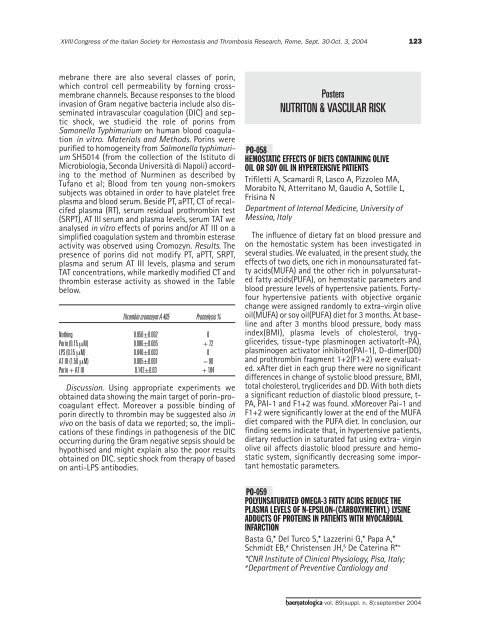Haematologica 2004;89: supplement no. 8 - Supplements ...
Haematologica 2004;89: supplement no. 8 - Supplements ...
Haematologica 2004;89: supplement no. 8 - Supplements ...
- No tags were found...
You also want an ePaper? Increase the reach of your titles
YUMPU automatically turns print PDFs into web optimized ePapers that Google loves.
XVIII Congress of the Italian Society for Hemostasis and Thrombosis Research, Rome, Sept. 30-Oct. 3, <strong>2004</strong>123mebrane there are also several classes of porin,which control cell permeability by forning crossmembranechannels. Because responses to the bloodinvasion of Gram negative bacteria include also disseminatedintravascular coagulation (DIC) and septicshock, we studieid the role of porins fromSamonella Typhimurium on human blood coagulationin vitro. Materials and Methods. Porins werepurified to homogeneity from Salmonella typhimuriumSH5014 (from the collection of the Istituto diMicrobiologia, Seconda Università di Napoli) accordingto the method of Nurminen as described byTufa<strong>no</strong> et al; Blood from ten young <strong>no</strong>n-smokerssubjects was obtained in order to have platelet freeplasma and blood serum. Beside PT, aPTT, CT of recalcifedplasma (RT), serum residual prothrombin test(SRPT), AT III serum and plasma levels, serum TAT weanalysed in vitro effects of porins and/or AT III on asimplified coagulation system and thrombin esteraseactivity was observed using Cromozyn. Results. Thepresence of porins did <strong>no</strong>t modify PT, aPTT, SRPT,plasma and serum AT III levels, plasma and serumTAT concentrations, while markedly modified CT andthrombin esterase activity as showed in the Tablebelow.Thrombin cromozym A 405 Proteolysis %Nothing 0.050±0.002 0Porin (0.15 µM) 0.086±0.005 + 72LPS (0.15 µM) 0.048±0.003 0AT III (1.50 µM) 0.005±0.001 − 90Porin + AT III 0.142±0.03 + 184Discussion. Using appropriate experiments weobtained data showing the main target of porin-procoagulanteffect. Moreover a possible binding ofporin directly to thrombin may be suggested also invivo on the basis of data we reported; so, the implicationsof these findings in pathogenesis of the DICoccurring during the Gram negative sepsis should behypothised and might explain also the poor resultsobtained on DIC. septic shock from therapy of basedon anti-LPS antibodies.PostersNUTRITON & VASCULAR RISKPO-058HEMOSTATIC EFFECTS OF DIETS CONTAINING OLIVEOIL OR SOY OIL IN HYPERTENSIVE PATIENTSTrifiletti A, Scamardi R, Lasco A, Pizzoleo MA,Morabito N, Atterrita<strong>no</strong> M, Gaudio A, Sottile L,Frisina NDepartment of Internal Medicine, University ofMessina, ItalyThe influence of dietary fat on blood pressure andon the hemostatic system has been investigated inseveral studies. We evaluated, in the present study, theeffects of two diets, one rich in mo<strong>no</strong>unsaturated fattyacids(MUFA) and the other rich in polyunsaturatedfatty acids(PUFA), on hemostatic parameters andblood pressure levels of hypertensive patients. Fortyfourhypertensive patients with objective organicchange were assigned randomly to extra-virgin oliveoil(MUFA) or soy oil(PUFA) diet for 3 months. At baselineand after 3 months blood pressure, body massindex(BMI), plasma levels of cholesterol, trygglicerides,tissue-type plasmi<strong>no</strong>gen activator(t-PA),plasmi<strong>no</strong>gen activator inhibitor(PAI-1), D-dimer(DD)and prothrombin fragment 1+2(F1+2) were evaluated.xAfter diet in each grup there were <strong>no</strong> significantdifferences in change of systolic blood pressure, BMI,total cholesterol, tryglicerides and DD. With both dietsa significant reduction of diastolic blood pressure, t-PA, PAI-1 and F1+2 was found. xMoreover Pai-1 andF1+2 were significantly lower at the end of the MUFAdiet compared with the PUFA diet. In conclusion, ourfinding seems indicate that, in hypertensive patients,dietary reduction in saturated fat using extra- virgi<strong>no</strong>live oil affects diastolic blood pressure and hemostaticsystem, significantly decreasing some importanthemostatic parameters.PO-059POLYUNSATURATED OMEGA-3 FATTY ACIDS REDUCE THEPLASMA LEVELS OF N-EPSILON-(CARBOXYMETHYL) LYSINEADDUCTS OF PROTEINS IN PATIENTS WITH MYOCARDIALINFARCTIONBasta G,* Del Turco S,* Lazzerini G,* Papa A,*Schmidt EB, # Christensen JH, § De Caterina R*°*CNR Institute of Clinical Physiology, Pisa, Italy;#Department of Preventive Cardiology andhaematologica vol. <strong>89</strong>(suppl. n. 8):september <strong>2004</strong>
















